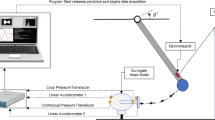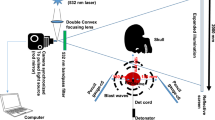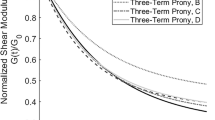Abstract
A combined experimental and numerical study was conducted to determine a method to elucidate the biomechanical response of a head surrogate physical model under air shock loading. In the physical experiments, a gel-filled egg-shaped skull/brain surrogate was exposed to blast overpressure in a shock tube environment, and static pressures within the shock tube and the surrogate were recorded throughout the event. A numerical model of the shock tube was developed using the Eulerian approach and validated against experimental data. An arbitrary Lagrangian-Eulerian (ALE) fluid–structure coupling algorithm was then utilized to simulate the interaction of the shock wave and the head surrogate. After model validation, a comprehensive series of parametric studies was carried out on the egg-shaped surrogate FE model to assess the effect of several key factors, such as the elastic modulus of the shell, bulk modulus of the core, head orientation, and internal sensor location, on pressure and strain responses. Results indicate that increasing the elastic modulus of the shell within the range simulated in this study led to considerable rise of the overpressures. Varying the bulk modulus of the core from 0.5 to 2.0 GPa, the overpressure had an increase of 7.2%. The curvature of the surface facing the shock wave significantly affected both the peak positive and negative pressures. Simulations of the head surrogate with the blunt end facing the advancing shock front had a higher pressure compared to the simulations with the pointed end facing the shock front. The influence of an opening (possibly mimicking anatomical apertures) on the peak pressures was evaluated using a surrogate head with a hole on the shell of the blunt end. It was revealed that the presence of the opening had little influence on the positive pressures but could affect the negative pressure evidently.
Similar content being viewed by others
References
Anzelius A (1943) The effect of an impact on a spherical liquid mass. Acta Pathologica et Microbiologica Scandinavica 48: 153–159
Bauman RA, Ling G, Tong L, Januszkiewicz A, Agoston D, Delanerolle N, Kim Y, Rizel D, Bell R, Ecklund J, Armonda R, Bandak F, Parks S (2009) An introductory characterization of combat-casualty-care relevant swine model of closed head injury resulting from exposure to explosive blast. J Neurotrauma 26: 841–860
Bowen IG, Fletcher ER, Richmond DR (1968) Estimate of man’s tolerance to the direct effects of air blast. Defense Atomic Support Agency, Report 2133, Loverlace Foundation, Albuquerque, NM
Bradshaw DRS, Morfey CL (2001) Pressure and shear response in brain injury models. In: Proceedings of the 17th international technical conference on the enhanced safety of vehicles, Amsterdam, The Netherlands
Brands DWA, Bovendeerd PHM, Peters GWM, Wismans JAHM, Paas MHJW, van Bree JLMJ (1999) Comparison of the dynamic behaviour of brain tissue and two model materials. In: 43rd Stapp car crash conference proceedings, pp 350–357
Cernak I (2005) Animal models of head trauma. J Am Soc Exp Neurother 2: 410–422
Cernak I, Wang Z, Jiang J, Bian X, Savic J (2001) Ultrastructural and functional characteristics of blast injury-induced neurotrauma. J Trauma Inj Infect Crit Care 50: 695–706
Chafi MS, Karami G, Ziejewski M (2007a) An assessment of primary blast injury in human brains—a numerical simulation. In: Proceedings of the 2007 ASME summer bioengineering conference, pp 349–350
Chafi MS, Karami G, Ziejewski M (2007b) Simulation of blast-head interactions to study traumatic brain injury. In: Proceedings of the 2007 international mechanical engineering congress and exposition, pp 211–220
Chavko M, Koller WA, Prusaczyk WK, McCarron RM (2007) Measurement of blast wave by a miniature fiber optic pressure transducer in the rat brain. J Neurosci Methods 159(2): 277–281
CONWEP (1991) Conventional weapons effects program; US army engineer waterways experimental station, Vicksburg, MS, USA
Courtney A, Courtney M (2009) A thoracic mechanism of mild traumatic brain injury due to blast pressure waves. Med Hypotheses 72(1): 76–83
Cullis IG (2001) Blast waves and how they interact with structures. J R Med Corps 147: 16–26
Dal Cengio Leonardi A, Bir CA, Ritzel DV, VandeVord PJ (2009) The effects of intracranial pressure sensor location and skull apertures during exposure of a rat model to an air shock wave. In: The second joint symposium of the international and national neurotrauma societies, Santa Barbara, CA, Poster Presentation, September 2009
DePalma RG, Burris DG, Champion HR, Hodgson MJ (2005) Blast injuries. New Engl Med 37: 664–678
Gaetani P, Guardone A, Persico G (2008) Shock tube flows past partially opened diaphragms. J Fluid Mech 602: 267–286
Hallquist JO (1998) LS-DYNA theoretical manual. Livermore Software Technology Co., Livermore, CA http://www.matweb.com/
Ivarsson J, Viano DC, Lovsund P (2002) Influence of the lateral ventricles and irregular skull base on brain kinematics due to sagittal plane head rotation. J Biomech Eng 124: 422–431
Kleiven S (2007) Predictors for traumatic brain injuries evaluated through accident reconstructions. Stapp Car Crash J 51: 81–114
Long JB, Bentley TL, Wessner KA, Cerone C, Sweeney S, Bauman RA (2009) Blast overpressure in rats: recreating a battlefield injury in the laboratory. J Neurotrauma 26: 1–14
LS-DYNA keyword user’s manual (2007) Version 971. Livermore Software Technology Co., Livermore, CA
Margulies SS, Thibault LE, Gennarelli TA (2003) Physical model simulations of brain injury in the primate. J Biomech 23: 823–836
Mayorga MA (1997) The pathology of primary blast overpressure injury. Toxicology 121: 17–28
Meyers MA (1994) Dynamic behavior of materials. Wiely, New York
Moore DF, Jerusalem A, Nyein M, Noels L, Jaffee MS, Radovitzky RA (2009) Computational biology—modeling of primary blast effects on the central nervous system. NeuroImage 47:T10–T20
Moss W, King MJ, Blackman EC (2009) Skull Flexture form blast waves: a new mechanism for brain injury with implications for helmet design. J Acoust Soc Am 125(4): 2650–2665
Parnaik Y, Beillas P, Demetropoulos CK, Hardy WN, Yang KH, King AI (2004) The influence of surrogate blood vessels on the impact response of a physical model of the brain. Stapp Car Crash J 48: 259–277
Ruan JS, Khalil TB, King AI (1994) Dynamic response of the human head to impact by three-dimensional finite element analysis. J Biomech Eng 116: 44–50
Säljö A, Arrhen F, Bolouri H, Mayorga M, Hamberger A (2008) Neuropathology and pressure in the pig brain resulting from low-impulse noise exposure. J Neurotrauma 25: 1397–1406
Säljö A, Bao F, Haglid KG, Hansson H-A (2000) Blast exposure causes redistribution of phosphorylated neurofilament subunits in neurons of the adult rat brain. J Neurotrauma 17(8): 719–726
Taber KH, Warden DL, Hurley RA (2006) Blast-related traumatic brain injury: what is known?. J Neuropsych Clin Neurosci 18(2): 141–145
Taylor PA, Ford CC (2009) Simulation of blast-induced early-time intracranial wave physics leading to traumatic brain injury. J Biomech Eng 131: 1–11
Teland et al (2010a) Numerical simulation of mechanisms of blast-induced traumatic brain injury. J Acoust Soc Am 127: 1790
Teland et al (2010b) Numerical simulation of mechanisms of blast-induced traumatic brain injury. POMA 9: 020004
Wightman JM, Gladish SL (2001) Explosions and blasts injuries. Ann Emerg Med 37: 664–678
Zhang L, Yang KH, King AI (2001) Comparison of brain responses between frontal and lateral impacts by finite element modeling. J Neurotrauma 18(1): 21–30
Zhang J, Song B, Pintar FA, Yoganandan N, Chen W, Gennarelli TA (2008) How to test brain and brain simulant at ballistic and blast strain rates. Biomed Sci Instrum 44: 129–134
Zhang J, Yoganandan N, Pintar FA, Gennarelli TA, Shender BS (2009) A finite element study of blast traumatic brain injury. Biomed Sci Instrum 45: 119–124
Zhang J, Yoganandan N, Pintar FA, Guan Y, Gennarelli TA (2007) Experimental model for civilian ballistic brain injury biomechanics quantification. J Biomech 40: 2341–2346
Zhu F, Lu G, Ruan D, Shu D (2009) Tearing of metallic sandwich panels subjected to air shock loading. Struc Eng Mech 32(2): 351–370
Author information
Authors and Affiliations
Corresponding author
Rights and permissions
About this article
Cite this article
Zhu, F., Wagner, C., Dal Cengio Leonardi, A. et al. Using a gel/plastic surrogate to study the biomechanical response of the head under air shock loading: a combined experimental and numerical investigation. Biomech Model Mechanobiol 11, 341–353 (2012). https://doi.org/10.1007/s10237-011-0314-2
Received:
Accepted:
Published:
Issue Date:
DOI: https://doi.org/10.1007/s10237-011-0314-2




